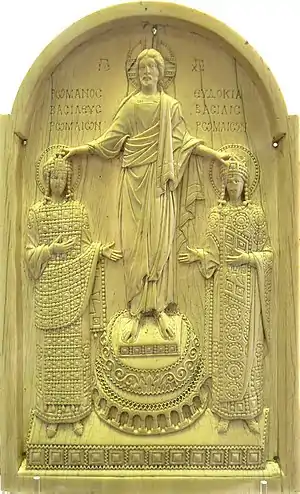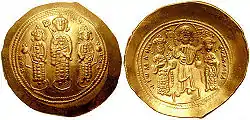Eudokia Makrembolitissa
Eudokia Makrembolitissa (or Eudocia Macrembolitissa) (Greek: Εὐδοκία Μακρεμβολίτισσα) (c. 1021 – 1096) was a Byzantine empress by her successive marriages to Constantine X Doukas and Romanos IV Diogenes. She acted as regent of her minor sons, Michael VII and Konstantios Doukas, in 1067–68, and resigned her regency by marriage to Romanos IV Diogenes. When he was deposed in 1071, she resumed the regency for her sons, but was forced to resign again.

Family
Eudokia Makrembolitissa was the niece of Michael Keroularios, the patriarch of Constantinople, whose sister had married John Makrembolites. Michael Psellos was very close to the family, and Eudokia considered him an "uncle". According to Psellos she was very noble, beautiful, and intelligent.[1] Eudokia married Constantine Doukas sometime before 1050. They had seven children, of whom six lived to adulthood:
- Michael VII Doukas
- Andronikos Doukas, co-emperor from 1068 to 1078
- Konstantios Doukas, co-emperor from c. 1060 to 1078, died 1081
- Anna Doukaina, a nun
- Theodora Doukaina, who married Doge Domenico Selvo of Venice
- Zoe Doukaina, who married Adrianos Komnenos, a brother of Emperor Alexios I Komnenos
Empress

Constantine became Byzantine emperor in 1059. When he died on 22 May 1067, Eudokia, as a crowned augusta, was confirmed as regent for their sons Michael VII and Konstantios, along with Constantine's brother, Caesar John Doukas. Michael VII was just old enough to rule on his own, but nevertheless was considered co-emperor with his younger brother, while Eudokia ran the administration of the empire.
Eudokia had also sworn on Constantine's deathbed not to remarry, and had even imprisoned and exiled Romanos Diogenes, who was suspected of aspiring to the throne. Perceiving that she was not able to avert the invasions which threatened the eastern frontier of the empire unaided,[2] however, she revoked her oath and married Romanos, without the approval of John Doukas, Patriarch John VIII of Constantinople, or Michael VII. She approached the patriarch and convinced him both to hand over the written oath she had signed to this effect, and to have him pronounce that he was in favour of a second marriage for the good of the state.[3] The Senate then agreed to the marriage. The wedding took place on 1 January 1068, and Romanus was immediately proclaimed co-emperor as Romanos IV.
With her new husband's assistance, Eudokia was able to dispel the impending danger. She had two sons with Romanos IV, Nikephoros and Leo. Another of Eudokia and Constantine's sons, Andronikos Doukas, was now made co-emperor by Romanos IV, although he had been excluded from power by his own father, mother, and brothers. However, Eudokia did not live very happily with her new husband, who was warlike and self-willed and increasingly excluded her from power.
When Romanos was taken prisoner by the Seljuk Turks at the Battle of Manzikert (1071), Eudokia and Michael again assumed the government,[2] until it was discovered that Romanos had survived and was returning to Constantinople. John Doukas and the Varangian Guard then compelled Eudokia to leave power to Michael and retire to a convent.[2]
After Michael VII was deposed in 1078 by Nikephoros III, Eudokia was recalled by the new emperor, who offered to marry her. This plan did not come to pass, due to the opposition of John Doukas, and Eudokia died as a nun sometime after the accession of Alexius I Comnenus in 1081.
Writings
Attributed to Eudokia is a dictionary of history and mythology, called Ἰωνιά (i.e. Collection or Bed of Violets). It is prefaced by an address to her husband Romanos Diogenes, and the work is described as "a collection of genealogies of gods, heroes, and heroines, of their metamorphoses, and of the fables and stories respecting them found in the ancients; containing also notices of various philosophers". However, the book is now thought to be a modern (16th-century) compilation, falsely attributed to Eudokia, and compiled by the counterfeiter Constantine Paleocappa around 1540.[4] The sources from which the work was compiled include Diogenes Laërtius and the Suda.[4]
Notes
- Psellus, Chronographia, Book ?? page ??.
- Chisholm 1911, pp. 881–882.
- Norwich 1993, p. 344.
- Dorandi 2013, p. .
References
- Dorandi, Tiziano (2013), "Introduction", Diogenes Laertius: Lives of Eminent Philosophers, Cambridge University Press, ISBN 0521886813
- Dzielska, Maria (1995), Hypatia of Alexandria, translated by Lyra, F., Harvard University Press, ISBN 0-674-43776-4
- Norwich, John Julius (1993), Byzantium: The Apogee, Penguin, ISBN 0-14-011448-3
- Psellus, Michael, Chronographia
Attribution:
 This article incorporates text from a publication now in the public domain: Chisholm, Hugh, ed. (1911), "Eudocia Macrembolitissa", Encyclopædia Britannica, 9 (11th ed.), Cambridge University Press, pp. 881–882
This article incorporates text from a publication now in the public domain: Chisholm, Hugh, ed. (1911), "Eudocia Macrembolitissa", Encyclopædia Britannica, 9 (11th ed.), Cambridge University Press, pp. 881–882 Smith, William, ed. (1870), "Eudocia Augusta Macrembolis", Dictionary of Greek and Roman Biography and Mythology, 2, p. 80
Smith, William, ed. (1870), "Eudocia Augusta Macrembolis", Dictionary of Greek and Roman Biography and Mythology, 2, p. 80
Further reading
- Garland, Lynda (1991), The Oxford Dictionary of Byzantium, Oxford University Press Missing or empty
|title=(help) - Byzantine Empresses: Woman and Power in Byzantium, AD 527–1204, Routledge, 1999
Eudokia Makrembolitissa Born: 1021 Died: 1096 | ||
| Royal titles | ||
|---|---|---|
| Preceded by Catherine of Bulgaria |
Byzantine Empress consort 1059–1071 |
Succeeded by Maria of Alania |